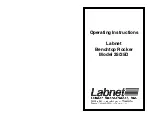
Attero Tech by QSC
Synapse D32Mi
User Manual
QSC, LLC 2020
614-00053
*Note:
The connections to the primary and secondary Dante™
networks don’t have to use the same type of port on the D16Mio.
They may be mixed so using a primary SFP connection and an
RJ45 secondary connection or vice versa are both perfectly
acceptable.
Once connections to the main primary and secondary networks
have been made, the unused ports can be used to create a daisy
chain to a nearby device. Simply connect the spare primary port
to the primary port of the nearby device. To maintain full
redundancy, the spare secondary port should also be connected
to the secondary port of the nearby device.
Figure 5 - "Redundant" mode with daisy chaining
*Note:
There are limitations using daisy chaining due to the
additional switch hops of a daisy chained switch/device in a
Dante™ network. While daisy chaining can certainly offer the
installer some benefits, careful consideration should be given as
to whether daisy chaining is suitable for any given application.
2.3.3 – Using on Standalone Network
The D32Mi supports both redundant mode and standalone mode
(indicated as “switched” mode in Dante™ Controller). If the D32Mi
is being used in a standalone network, running the D32Mi in
either “Redundant” or “Switched mode is perfectly acceptable and
will work so even though the DM16Mio is setup in “Redundant”
mode by default, it can and will work happily in a standalone
network without changing anything. However, only the primary
SFP port or primary Ethernet port of the DM16Mio may then be
connected to a standalone Dante™ network.
*Note:
Connecting either secondary port to a standalone Dante™
network while the D16Mio is still set in “Redundant” mode will
cause problems due to the IP address setup of the secondary ports
having completely different IP addresses. Therefore this should
be avoided.
Figure 6 - "Standalone" connection in “Redundant” mode
For full flexibility in a standalone network, the D32Mi should be
reconfigured to “Switched” mode. This is easily done by
connecting one of the primary ports to the standalone Dante™
network and then using Dante™ controller to switch the mode.
Figure 7 - "Standalone" connection in "Switched" mode
In “Switched” mode, the D32Mi reverts to using a single internal
network connection with a single IP address. The concept of
primary and secondary ports become irrelevant and all of the
ports (both SFP and RJ45) are connected together on the same
network essentially turning the DM16Mio into a regular four port
network switch.
In this mode, the Dante™ network can be connected to any of the
four ports. Any unused ports may then be used to connect other
devices in a daisy chain. As the D32Mi is acting as a switch, other
devices connected to the D32Mi must then count the D32Mi as a
switch hop.































